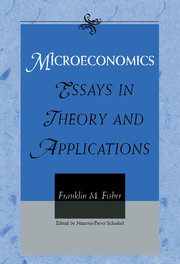Book contents
- Frontmatter
- Contents
- Introduction
- Part I Disequilibrium and Stability
- 1 The Formation of Economic Magnitudes: Disequilibrium and Stability (1990)
- 2 Quasi-Competitive Price Adjustment by Individual Firms: A Preliminary Paper (1970)
- 3 Stability and Competitive Equilibrium in Two Models of Search and Individual Price Adjustment (1973)
- 4 On Price Adjustment without an Auctioneer (1972)
- 5 Quantity Constraints, Spillovers, and the Hahn Process (1978)
- 6 On Stability Analysis with Disequilibrium Awareness (1988)
- 7 It Takes t* to Tango: Trading Coalitions with Fixed Prices (1989)
- 8 An Alternate Proof and Extension of Solow's Theorem on Nonnegative Square Matrices (1962)
- 9 Choice of Units, Column Sums, and Stability in Linear Dynamic Systems with Nonnegative Square Matrices (1965)
- 10 A Simple Proof of the Fisher–Fuller Theorem (1972)
- 11 Gross Substitutes and the Utility Function (1972)
- Part II Welfare Economics and Consumer Theory
- Part III Applications of Microeconomic Theory
- Part IV Industrial Organization, Economics, and the Law
- Part V Public Policy Applications
- Epilogue
- Indexes
10 - A Simple Proof of the Fisher–Fuller Theorem (1972)
Published online by Cambridge University Press: 20 March 2010
- Frontmatter
- Contents
- Introduction
- Part I Disequilibrium and Stability
- 1 The Formation of Economic Magnitudes: Disequilibrium and Stability (1990)
- 2 Quasi-Competitive Price Adjustment by Individual Firms: A Preliminary Paper (1970)
- 3 Stability and Competitive Equilibrium in Two Models of Search and Individual Price Adjustment (1973)
- 4 On Price Adjustment without an Auctioneer (1972)
- 5 Quantity Constraints, Spillovers, and the Hahn Process (1978)
- 6 On Stability Analysis with Disequilibrium Awareness (1988)
- 7 It Takes t* to Tango: Trading Coalitions with Fixed Prices (1989)
- 8 An Alternate Proof and Extension of Solow's Theorem on Nonnegative Square Matrices (1962)
- 9 Choice of Units, Column Sums, and Stability in Linear Dynamic Systems with Nonnegative Square Matrices (1965)
- 10 A Simple Proof of the Fisher–Fuller Theorem (1972)
- 11 Gross Substitutes and the Utility Function (1972)
- Part II Welfare Economics and Consumer Theory
- Part III Applications of Microeconomic Theory
- Part IV Industrial Organization, Economics, and the Law
- Part V Public Policy Applications
- Epilogue
- Indexes
Summary
Several years ago, Fisher and Fuller (1958) proved that if P is a real square matrix with all members of its “nested set” of principal minors non-zero, then there exists a real diagonal matrix, D, such that the characteristic roots of DP are all real, negative, and distinct. This interesting and powerful result, used by the authors to derive further results concerning convergence of linear iterative processes, has since also proved of interest to economists studying the stability of economic general equilibrium.
Fisher and Fuller's original proof of their theorem, however, is quite laborious, requiring fairly detailed examination of the characteristic polynomial. As it happens, it is possible to give a much simpler proof (although not a technically more elementary one), and that is the purpose of the present note.
Fisher and Fuller consider the following condition on a real n × n matrix, P.
(A) P has at least one sequence of non-zero principal minors, Mk of every order k = 1, …, n, such that Mk−1 is one of the k first principal minors of Mk.
(I shall call such a sequence of principal minors – whether its members are non-zero or not – a “nested set”.) They prove:
Theorem 1.If P is a real n × n matrix satisfying (A), then there exists a real diagonal matrix, D = diag (dt) such that the characteristic roots of DP are all real, negative, and distinct.
- Type
- Chapter
- Information
- MicroeconomicsEssays in Theory and Applications, pp. 170 - 173Publisher: Cambridge University PressPrint publication year: 1999



